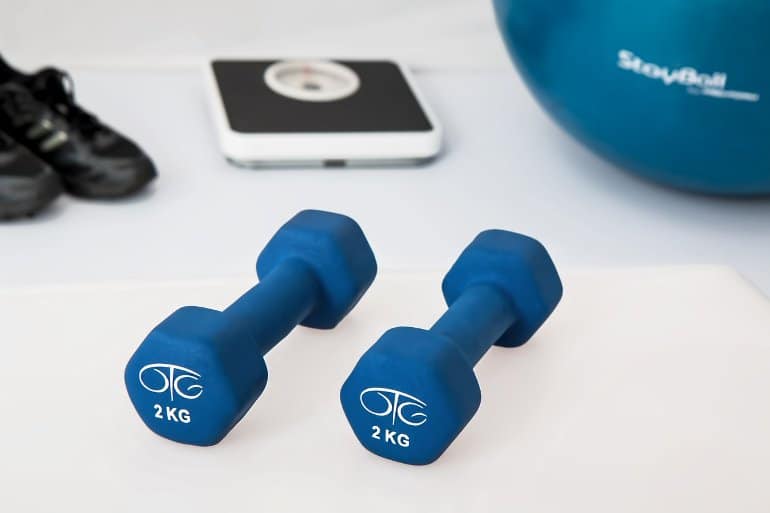Summary: Three to four one-minute bouts of vigorous physical activity a day, such as running for a bus or walking fast to complete tasks reduces the risk of all-cause and cancer-related death by 40%, and a 49% reduced risk of death from cardiovascular disease.
Source: University of Sydney
In good news for those who don’t like playing sport or going to the gym, new research finds just three to four one-minute bursts of huffing and puffing during daily tasks is associated with large reductions in the risk of premature death, particularly from cardiovascular disease.
Published in Nature Medicine today, the study is led by the University of Sydney’s Charles Perkins Centre in Australia. It is the first to accurately measure the health benefits of what researchers have termed ‘vigorous intermittent lifestyle physical activity’ or VILPA.
VILPA is the very short bouts of vigorous activity (up to one to two minutes) we do with gusto each day, like running for the bus, bursts of power walking while doing errands or playing high-energy games with the kids.
The researchers found that just three to four one-minute bouts of VILPA every day is associated with up to 40 percent reduction in all-cause and cancer-related mortality, and up to a 49 percent reduction in death related to cardiovascular disease.
“Our study shows similar benefits to high-intensity interval training (HIIT) can be achieved through increasing the intensity of incidental activities done as part of daily living, and the more the better,” said lead author Emmanuel Stamatakis, Professor of Physical Activity, Lifestyle and Population Health at the University of Sydney’s Charles Perkins Centre.
“A few very short bouts totaling three to four minutes a day could go a long way, and there are many daily activities that can be tweaked to raise your heart rate for a minute or so.”
The majority of adults aged 40 and over do not take part in regular exercise or sport, but Professor Stamatakis said the study reveals how incidental physical activity can overcome many barriers.
“Upping the intensity of daily activities requires no time commitment, no preparation, no club memberships, no special skills. It simply involves stepping up the pace while walking or doing the housework with a bit more energy,” he said.
What did they discover about exercise as part of daily life?
- About 89 percent of all participants did some VILPA.
- Among those who did VILPA:
- 93 percent of all VILPA bouts last up to 1 minute.
- On average each day participants did eight VILPA bouts of up to 1 minute each, totalling 6 minutes a day.
- On average each VILPA bout lasted around 45 seconds.
- The steepest gains were seen when comparing those with around four to five bouts per day to those with no VILPA.
- However, larger benefits were found with larger VILPA amounts, suggesting the more the better.
- The maximum of 11 bouts per day was associated with a 65 percent reduction in cardiovascular death risk and 49 percent reduction in cancer-related death risk, compared to no VILPA.
Interestingly, a comparative analysis of the vigorous activity of 62,000 people who regularly engaged in exercise found comparable results. This implies that whether the vigorous activity is done as part of structured exercise or housework do not compromise the health benefits.
How was the study conducted?
Researchers used wrist-worn tracker data from UK Biobank, a large-scale biomedical database, to measure the activity of over 25,000 ‘non-exercisers’, participants who self-reported that they do not do any sports or exercise during leisure time.
By this method, the researchers could conclude that any activity recorded by this group was incidental physical activity done as part of everyday living.
The team then accessed health data that allowed them to follow participants over seven years.
The studies are observational, meaning they cannot directly establish cause and effect. However, the researchers took rigorous statistical measures to minimise the possibility that results are explained by differences in health status between participants.
“These findings demonstrate just how valuable detailed and objective measures of physical activity can be when collected on a large-scale population. We are incredibly grateful to all of the 100,000 UK Biobank participants who wore an activity monitor for 7 days to generate these valuable data,” said Professor Naomi Allen, Chief Scientist of UK Biobank.
Call for an update to physical activity guidelines
The international team from the University of Sydney, the University of Oxford’s Big Data Institute (UK), University College London (UK), University of Glasgow (UK), University of Southern Denmark and McMaster University (Canada) are calling for physical activity guidelines and clinical advice to be updated to keep pace with this evolving area.

Current global guidelines imply that the health benefits of vigorous-intensity physical activity are gained through structured physical activity such as sport or running during leisure time.
It was only in 2020 that the WHO global Guidelines on Physical Activity and Sedentary Behaviour, co-chaired by Professor Stamatakis, acknowledged that ‘all activity counts’ and the stipulation that activity should be accumulated in 10-minute bouts was removed.
“Our previous knowledge about the health benefits of vigorous physical activity comes from questionnaire-based studies, but questionnaires cannot measure short bouts of any intensity,” said Professor Stamatakis.
“The ability of wearable technology to reveal “micropatterns” of physical activity, such as VILPA, holds huge potential for understanding the most feasible and time-efficient ways people can benefit from physical activity, no matter whether it is done for recreation or as part of daily living.”
The authors declare no competing interests.
Funding: The study is funded by an Australian National Health and Medical Research Council Investigator Grant and Ideas Grant. Individual researchers are supported by funding from the Welcome Trust, National Institute for Health Research Oxford Biomedical Research Centre, Novo Nordisk, the British Heart Foundation Centre of Research Excellence, the Alan Turing Institute, the British Heart Foundation, Health Data Research UK (an initiative funded UK Research and Innovation, Department of Health and Social Care and the devolved administrations, and leading medical research charities.
About this exercise and longevity research news
Author: Michelle Blowes
Source: University of Sydney
Contact: Michelle Blowes – University of Sydney
Image: The image is in the public domain
Original Research: Open access.
“Association of wearable device-measured vigorous intermittent lifestyle physical activity with mortality” by Emmanuel Stamatakis et al. Nature Medicine
Abstract
Association of wearable device-measured vigorous intermittent lifestyle physical activity with mortality
Wearable devices can capture unexplored movement patterns such as brief bursts of vigorous intermittent lifestyle physical activity (VILPA) that is embedded into everyday life, rather than being done as leisure time exercise.
Here, we examined the association of VILPA with all-cause, cardiovascular disease (CVD) and cancer mortality in 25,241 nonexercisers (mean age 61.8 years, 14,178 women/11,063 men) in the UK Biobank. Over an average follow-up of 6.9 years, during which 852 deaths occurred, VILPA was inversely associated with all three of these outcomes in a near-linear fashion.
Compared with participants who engaged in no VILPA, participants who engaged in VILPA at the sample median VILPA frequency of 3 length-standardized bouts per day (lasting 1 or 2 min each) showed a 38%–40% reduction in all-cause and cancer mortality risk and a 48%–49% reduction in CVD mortality risk. Moreover, the sample median VILPA duration of 4.4 min per day was associated with a 26%–30% reduction in all-cause and cancer mortality risk and a 32%–34% reduction in CVD mortality risk.
We obtained similar results when repeating the above analyses for vigorous physical activity (VPA) in 62,344 UK Biobank participants who exercised (1,552 deaths, 35,290 women/27,054 men). These results indicate that small amounts of vigorous nonexercise physical activity are associated with substantially lower mortality.
VILPA in nonexercisers appears to elicit similar effects to VPA in exercisers, suggesting that VILPA may be a suitable physical activity target, especially in people not able or willing to exercise.


